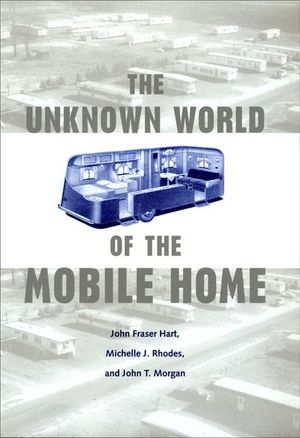The Unknown World of the Mobile Home
Published by Johns Hopkins University Press
An in-depth look at the history and culture of mobile homes in the United States.
In American popular imagination, the mobile home evokes images of cramped interiors, cheap materials, and occupants too poor or unsavory to live anywhere else. Since the 1940s and ‘50s, however, mobile home manufacturers have improved standards of construction and now present them as an affordable alternative to conventional site-built homes. Today one of every fourteen Americans lives in a mobile home.
In The Unknown World of the Mobile Home authors John Fraser Hart, Michelle J. Rhodes, and John T. Morgan illuminate the history and culture of these often misunderstood domiciles. They describe early mobile homes, which were trailers designed to be pulled behind automobiles and which were more often than not poorly constructed and unequal to the needs of those who used them. During the 1970s, however, Congress enacted federal standards for the quality and safety of mobile homes, which led to innovation in design and the production of much more attractive and durable models. These models now comply with local building codes and many are designed to look like conventional houses. As a result, one out every five new single-family housing units purchased in the United States is a mobile home, sited everywhere from the conventional trailer park to custom-designed “estates” aimed at young couples and retirees. Despite all these changes in manufacture and design, even the most immobile mobile homes are still sold, financed, regulated, and taxed as vehicles.
With a wealth of detail and illustrations, The Unknown World of the Mobile Home provides readers with an in-depth look into this variation on the American dream.
“A clear, concise, and innovative look at the history, the economics, and the politics of the mobile home. The authors reveal the inner workings of mobile home living by drawing upon a wide variety of sources, from industry data to interviews conducted at mobile home parks across the country. Further, they explore new types of mobile home communities—those assembled for workers at meat-processing centers in southwest Kansas, for example—that complicate the familiar image of the mobile home park as retirement village. The ideas presented in this book provide a solid starting point for many detailed studies on this important topic.” —Karl Raitz, University of Kentucky, author of The National Road
In American popular imagination, the mobile home evokes images of cramped interiors, cheap materials, and occupants too poor or unsavory to live anywhere else. Since the 1940s and ‘50s, however, mobile home manufacturers have improved standards of construction and now present them as an affordable alternative to conventional site-built homes. Today one of every fourteen Americans lives in a mobile home.
In The Unknown World of the Mobile Home authors John Fraser Hart, Michelle J. Rhodes, and John T. Morgan illuminate the history and culture of these often misunderstood domiciles. They describe early mobile homes, which were trailers designed to be pulled behind automobiles and which were more often than not poorly constructed and unequal to the needs of those who used them. During the 1970s, however, Congress enacted federal standards for the quality and safety of mobile homes, which led to innovation in design and the production of much more attractive and durable models. These models now comply with local building codes and many are designed to look like conventional houses. As a result, one out every five new single-family housing units purchased in the United States is a mobile home, sited everywhere from the conventional trailer park to custom-designed “estates” aimed at young couples and retirees. Despite all these changes in manufacture and design, even the most immobile mobile homes are still sold, financed, regulated, and taxed as vehicles.
With a wealth of detail and illustrations, The Unknown World of the Mobile Home provides readers with an in-depth look into this variation on the American dream.
“A clear, concise, and innovative look at the history, the economics, and the politics of the mobile home. The authors reveal the inner workings of mobile home living by drawing upon a wide variety of sources, from industry data to interviews conducted at mobile home parks across the country. Further, they explore new types of mobile home communities—those assembled for workers at meat-processing centers in southwest Kansas, for example—that complicate the familiar image of the mobile home park as retirement village. The ideas presented in this book provide a solid starting point for many detailed studies on this important topic.” —Karl Raitz, University of Kentucky, author of The National Road
BUY NOW FROM
COMMUNITY REVIEWS
